Pomelo is all about interfacing with as many things as possible. Theremino MCA is a popular open-source gamma spectroscopy software designed to work with DIY detectors. It relies on the PC’s sound card for digitizing pulses in order to build a spectrum.
Pomelo Core makes internal analog signals available on a pin header, mostly for debugging. Among these there is a low-pass filtered version of the SiPM output. Unfortunately, it’s still a bit too fast to be properly digitized by a PC sound card and while it does work, the results are a bit wonky. But if we slow it down a bit more using an RC low-pass filter, it becomes just right. I used 10 kOhm and 10 nF.
To get a feel for how well the pulse amplitudes match between the Pomelo Core output and the signal that is read by the sound card I grabbed some pulses both with a Saleae logic analyzer and with Audacity and manually aligned the time scales to look at the same pulses.

Pulses from a Th-232 source at different stages in the analog chain. The time scale is manually aligned to look at the same pulses in both Saleae Logic and Audacity.

Same plot as above but zoomed in to see the shapes of individual pulses
The sound card is detecting pulses as being negative, despite the Pomelo output being positive. I inverted the waveform in Audacity to make things easier to see.
One thing to notice is that the RC filtered signal rides on a DC baseline of ~2.5V. This is due to the PC’s sound card providing bias for the microphone -- it’s not a huge problem for Pomelo, as its output is fed directly from a stiff source, an op-amp’s output. The 10 kOhm resistor nicely isolates these two.
The spectrum of a Th-232 source looks very good both in the Theremino MCA software, as well as exported and displayed alongside the spectrum recorded by Pomelo Core.

Th-232 spectrum and individual pulse in the Theremino MCA software

Spectra taken with both Pomelo Core as well as with Theremino MCA, with uncalibrated x axes scaled to cover the same energy range
 mihai.cuciuc
mihai.cuciuc
Discussions
Become a Hackaday.io Member
Create an account to leave a comment. Already have an account? Log In.